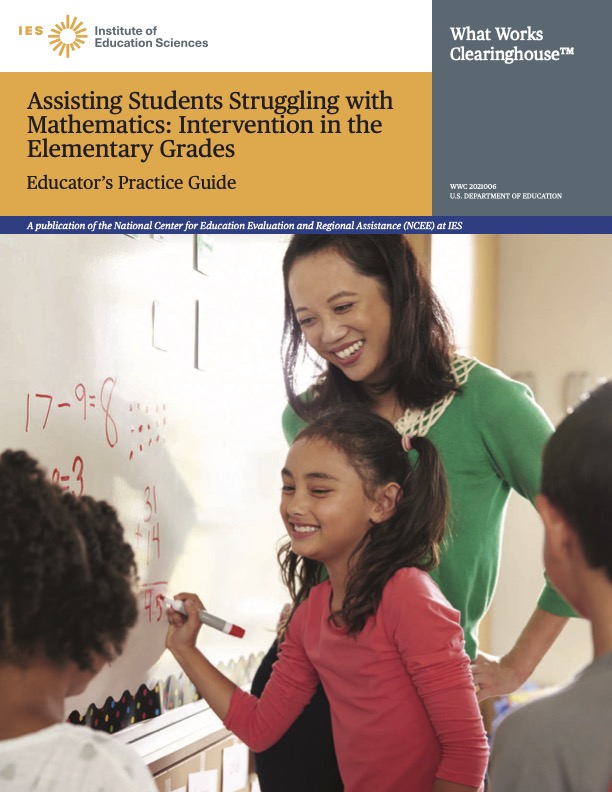While perusing the What Works Clearinghouse (WWC) website to learn about – go figure – what works for improving math instruction, I stumbled upon the gem of a document called Assisting Students Struggling with Mathematics: Intervention in the Elementary Grades. You can download the document here.
 The name of the document is unfortunate because the title suggests it is only for intervention. This could not be further form the truth! The guide provides six evidence-based practices that can help teachers tailor their instructional approaches to meet the needs of their students. Of course, the recommendations also apply to the mathematics intervention programs school sites might offer.
The name of the document is unfortunate because the title suggests it is only for intervention. This could not be further form the truth! The guide provides six evidence-based practices that can help teachers tailor their instructional approaches to meet the needs of their students. Of course, the recommendations also apply to the mathematics intervention programs school sites might offer.
The six recommendations:
- Systematic Instruction: Provide systematic instruction during intervention to develop student understanding of mathematical ideas.
- Mathematical Language: Teach clear and concise mathematical language and support students’ use of the language to help students effectively communicate their understanding of mathematical concepts.
- Representations: Use a well-chosen set of concrete and semi-concrete representations to support students’ learning of mathematical concepts and procedures.
- Number Lines: Use the number line to facilitate the learning of mathematical concepts and procedures, build understanding of grade-level material, and prepare students for advanced mathematics.
- Word Problems: Provide deliberate instruction on word problems to deepen students’ mathematical understanding and support their capacity to apply mathematical ideas.
- Timed Activities: Regularly include timed activities as one way to build fluency in mathematics.
Each recommendation is itself worthy of a blog post. The first five ideas are pretty awesome and not particularly controversial. We need to do some serious thinking about how to make recommendations 1 through 5 a DAILY occurrence in EVERY classroom. I can find some examples of them happening in some classrooms some of the time, but the the recommendations 1-5 are absolutely not baked into the system such that every student is equally likely to benefit from these things. Let’s start there.
But for now I will focus only on #6: Timed Activities.
I have observed on Twitter a tremendous amount of hand wringing and gnashing of teeth about the recommendation to regularly include timed activities to build fluency. I thought I would chime in with my unsolicited musings about ALL SIX recommendations, with an additional point of view for #6.
There is lots of arguing (veering into name-calling) about whether or not we should use timed activities and whether they cause math anxiety. I want to share my thoughts about timed activities by beginning with a personal story about “timed activities” and why that phrase does NOT conjure images of math as an anxiety-producing torture device.
I recently went to the doctor who promptly told me I was overweight and needed to exercise at least 20 minutes each day. She recommended that I walk, ride my bike, garden, or do any other physical activity I enjoy. The key here is she did NOT tell me I had to go FAST. She merely said I should exercise 20 min/day and notice over time how I gradually feel better during those 20 minutes. She told me to notice that over time I will be less out of breath. Or perhaps I might walk/bike further in my 20 minutes.
Again she did not say to go FAST. Just exercise daily and notice improvement.
It is in this spirit of casual daily exercise that I think of timed activities with mathematics.
If we use Mad Minutes to cause students to frantically go as fast as they can, then that would be like my doctor telling me to SPRINT for my 20 minutes of daily exercise.
Sprinting would cause anxiety!
The purpose of Recommendation #6 is to create classroom timed activities that allow students to mathematically “walk” and notice their improvement over time. Students who progress to the point where they WANT to sprint is absolutely okay.
With mathematically “walking” during the timed activities, I’m suggesting students recall their basic facts at a pace that allows them to seamlessly make progress during problem-solving and practicing procedural fluency without having to divert their focus on the basic facts involved. This is about 2-3 seconds per recalled fact.
These timed activities also need to be carefully created to allow students to develop fluency in a particular strategy rather than random questions to be solved w/ a hodgepodge of strategies.
Over time these timed activities will lead to the fact fluency we want.
My belief: Requiring all students to engage in Mad Minutes that force all students to SPRINT is not good for students. For some students it is downright damaging. Instead let’s craft timed activities that allow students to mathematically “walk”, allowing students to enjoy the journey towards fluency.
The goal for ALL students is to mathematically “walk” (immediate recall of basic facts…2-3 seconds per fact), but those students who also want to “sprint” are also welcome to do that.
I welcome conversation about this!
.
.
.

